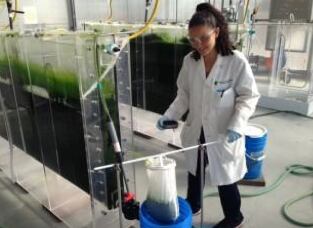The Toronto-based company, until early June known as Solutions4CO2, is running its test at the Arizona Center for Algae Technology and Innovation (AzCATI), a spin-off institution associated with Arizona State University in Tempe. The company had first developed its technology in conjunction with McMaster University in Ontario. This latest test at what Dil Vashi, BlueOcean’s director of corporate development calls the “foremost center for algae research in North America, and perhaps the world,” will bring third-party validation of the company’s technology and the quality of the product, which is an algal omega-3 oil with high DHA and significant EPA content.
An issue right from the start with algae ingredients has been their cost. Finding a way to scale up promising technologies cost effectively has been a hurdle, one that a number of companies have been unable to overcome. Vashi believes BlueOcean has found a way over that hurdle with a combination of patented technology and the use of off-the-shelf components and inputs.
Name change
The genesis of the company’s technology was a system to infuse CO2 into a growth medium more effectively, boosting growth rates. Originally this was aimed at finding a way to use waste CO2 from facilities like ethanol plants to produce value-added biomass. But Vashi said the CO2 requirements for algae production are modest in comparison to the hundreds of thousands of tons of waste gas produced annually by the average ethanol plant, so the carbon-sink angle never really played out. And the company was also involved at first in supercritical CO2 extraction, but has moved on to a proprietary ethanol extraction process for its algal ingredients. So the CO2 moniker no longer made much sense, and the BlueOcean name was chosen both for its connection to the salt-water algal species the company cultivates as well as the use of its patented extraction technology for use to extract nutraceutical ingredients from the byproducts of cold water shrimp processing.
CO2 for algae
Even though the infusion technolgoy didn’t take off as a way to get rid of waste gas, it did have powerful implications for algae production, Vashi told NutraIngredients-USA.
“We have a proprietary, patented CO2 infusion technology that yields three times better growth rates compared to a sparging technique. And the specific strain we have chosen is high in EPA and has DHA in it as well. We have the CO2 protocols, the lighting protocols. We have a system that will now be validated at a pilot scale,” Vashi said.
Test to run through September

The test at AzCATI is scheduled to run through September. It will use BlueOcean’s pilot unit, which is based on a standard 250-gallon tote, widely available to transport and store liquid ingredients. The company’s full scale design is based on growing algae in standard 20-foot rolloff bins that can hold 6,000 gallons of growth medium. The company’s planned full-scale facility will employ about 20 of these containers, Vashi said.
The company is propagating a salt-water photosynthetic strain (the strain’s identity remains a trade secret). Unlike other companies using photosynthetic organisms, BlueOcean chose not to rely on the sun for its light source, which is why so many competing operations are located in sunny climes. BlueOcean’s design instead uses LED lights, which not only allows a production plant to be sited anywhere that’s convenient, but also allows for precise control of the spectrum and intensity of the light for maximal growth, Vashi said.
Letting in the light
One issue that photosynthetic algae growers have to contend with is that the organisms can sometimes grow too enthusiastically. This makes for a dense, increasingly opaque surface layer which prevents light from reaching the layers beneath, ultimately flattening the growth curve. Some producers deal with this by agitating their ponds, growing algae in thin tubes or by choosing strains that are a lighter green in color so as to be more transparent.
BlueOcean’s way around this to mount the LED lights atop clear tubes that extend down into the growing medium. The tubes direct the light down into the medium much as fiber optic cables direct light-based signals along their length. This ensures that even cells at the bottom of the tank receive adequate light.
Water is water
Another way that BlueOcean saves money is by recycling almost all of the water in the extraction process. A number of companies growing salt-water algae in open ponds tout their water sources, whether it is water drawn from a nearby ocean or from brackish aquifers underlying desert locations. For BlueOcean, off-the-shelf water is just fine, so to speak. With its proprietary CO2 infusion, the company can achieve a growth rate in which the culture doubles about every 26 to 28 hours, so the protocol calls for continuous, daily extraction, Vashi said.
“It costs about $3,000 to make the salt water to initially fill one of the roll off bins. We recycle about 99% of the water in the extraction, so we just need a little bit of top off water, say $30 a day. If you were losing a lot of water from evaporation in an open pond and had to put in $600 worth of salt water a day, that starts to add up,” Vashi said.
